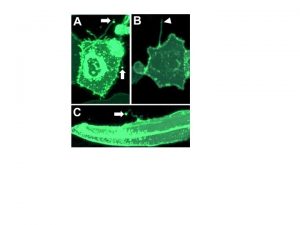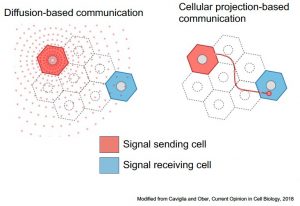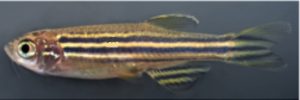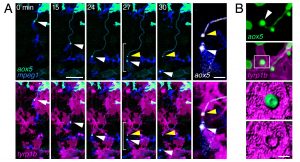Cellular protrusion mediated long-range cell-to-cell communication
The research goal of the Eom lab is to discover the cellular and molecular mechanisms of long-range intercellular communication mediated by a novel signaling protrusion called ‘airinemes’.
Mechanisms underlying morphogenesis and pattern formation are one of the most critical questions in developmental biology. Cells acquire positional identities by communicating with cells of the signaling center in a distance and interpret this information to form shapes and patterns. Long-range signaling via morphogen diffusion is relatively well established. However, it is still controversial since this model may lack the necessary precision and reliability. Recently, the importance of other types of long-distance signaling modalities utilizing direct contact through cellular projections has been emerging. These cellular projections are filopodia-like but considerably longer and play crucial signaling roles in various contexts. Nevertheless, the fundamental questions underlying the mechanisms of their regulation, delivery of signaling molecules, and targeting remain largely unexplored.
We discovered a novel type of cellular projection-mediated signaling modality utilizing a distinct cellular projection, which we named “airinemes”. Airinemes extend up to ~250μm and last for seconds to hours depending on their target specificity. One interesting difference between airinemes and other cellular projection-mediated signaling is that airinemes have membrane-bound vesicles at their tips (Figure 1, arrowheads; referred to as airineme vesicles), which carry Delta ligands and possibly other signaling molecules. Airinemes are extended from xanthoblasts, undifferentiated yellow pigment cells, which play a critical role in stripe pigment pattern formation in zebrafish. We found that airinemes are indispensable for post-embryonic stripe formation through airineme dependent delivery of Delta ligand from xanthoblasts to target melanophores (another type of pigment cell forms black strips). It has long been suggested that the long-distance signaling between melanophores and xanthophore lineages is mediated by diffusible factors, predicted by the reaction-diffusion model. Nevertheless, We propose that it is mediated by direct contact-mediated signaling through airinemes.
Figure 1. Adult zebrafish with black stripes and light interstripes (upper). Time-lapse frames show xanthoblast (aox5+, green) extend airineme and the vesicle (arrowhead) is associated with a macrophage (mpeg1+, blue) (lower).
Strikingly, we discovered that macrophages pick up the airineme vesicles from the surface of xanthoblasts, pull and deposit them onto target melanophores where vesicles will later be phagocytosed by other macrophages. Macrophages are well-known innate immune cells that clear dead cells and pathogens. Our findings show that macrophages are a key player in long-range signaling by initiating the delivery of airineme vesicles as well as terminating them by phagocytosis during adult pigment pattern formation in zebrafish. Most recently, my lab has observed airineme-like projections from non-pigment cell types, thus it is possible that airineme/macrophage-mediated signaling could be a common mechanism in nature.
Figure 2. Various cell types extend airineme-like projections.
Current Lab Projects
- Understanding the biology of airineme extension and the subcellular structures of airinemes
- Mechanisms of airineme-macrophage interaction and target recognition
- Cellular protrusion-mediated intercellular signaling between stem cells in zebrafish skin, and skin disease models
- Mathematical modeling of airineme-mediated intercellular communication
- Airineme-mediated signaling in human skin organoids
Selected Publications
- Bowman RL, Kim J, Eom DS (2024) CD44 facilitates adhesive interactions in airineme-mediated intercellular signaling. https://www.biorxiv.org/content/10.1101/2024.02.27.582398v1
- Wang Y, He Q, Has O, Forouzesh K, Eom DS (2023) Cytoneme-mediated intercellular signaling in keratinocytes essential for epidermal remodeling. bioRxiv: https://biorxiv.org/cgi/content/short/2023.11.08.566303v3
- Bowman RL, Wang D, Eom DS (2023) A macrophage subpopulation promotes airineme-mediated intercellular communication in a Matrix Metalloproteinase-9-dependent manner. Cell Reports https://www.cell.com/cell-reports/fulltext/S2211-1247(23)00829-X
- Park S, Kim H, Wang Y, Eom DS*, Allard J*. (2022) Zebrafish airinemes optimize between ballistic and diffusive search. eLife https://elifesciences.org/articles/75690 (*co-corresponding author)
- Eom DS. (2020) Airinemes: thin cellular protrusions mediate long-distance signaling guided by macrophages. Open Biology https://doi.org/10.1098/rsob.20039
- Eom DS, Parichy DM. (2017) A macrophage relay for long-distance signaling during post-embryonic tissue remodeling. Science 355(6331):1317-1320.
– Perspective: Science 355(6331):1258-1259
– Previews: Dev Cell 40(6): 520-521
– Faculty of 1000 (https://f1000.com/prime/727315348) - Eom DS, Bain EJ, Patterson LB, Grout M, Parichy DM. (2015) Long-distance communication by specialized cellular projections during pigment pattern development and evolution. eLife 10.7554/eLife.12401.
– Highlighted in eLife Insight 2016 DOI:10.7553/eLife.14239
– Faculty of 1000 (http://f1000.com/prime/726037413) - McMenamin SK, Bain EJ, McCann AE, Patterson LB, Eom DS, Waller ZP, Hamill JC, Kuhlman JA, Eisen JS, Parichy DM. (2014) Thyroid hormone-dependent adult pigment cell lineage and pattern in zebrafish. Science 345(6202):1358-1361.
- Eom DS, Amarnath S, Agarwala S. (2013) Apicobasal polarity and neural tube closure. Dev Growth Differ. 55(1):164-172.
- Eom DS*, Inoue S*, Patterson LB, Gordon TN, Slingwine R, Kondo S, Watanabe M, Parichy DM. (2012) Melanophore migration and survival during zebrafish adult pigment stripe development require the immunoglobulin superfamily adhesion molecule, igsf11. PLoS Genet. 8(8) e1002899 (*co-first author)
– Highlighted in Pigment Cell & Melanoma Research 2012 DOI:10.1111 - Eom DS, Smita A, Fogel LJ, Agarwala S. (2011) Bone morphogenetic proteins regulate neural tube closure by interacting with the apicobasal polarity pathway. Development (138) 3179-3188.
– Featured article in Development
– Faculty of 1000 (http://f1000.com/prime/11942956)
– Textbook : Developmental Biology 11th edition, Gilbert and Barresi, Chapter 13, pg. 420-421






